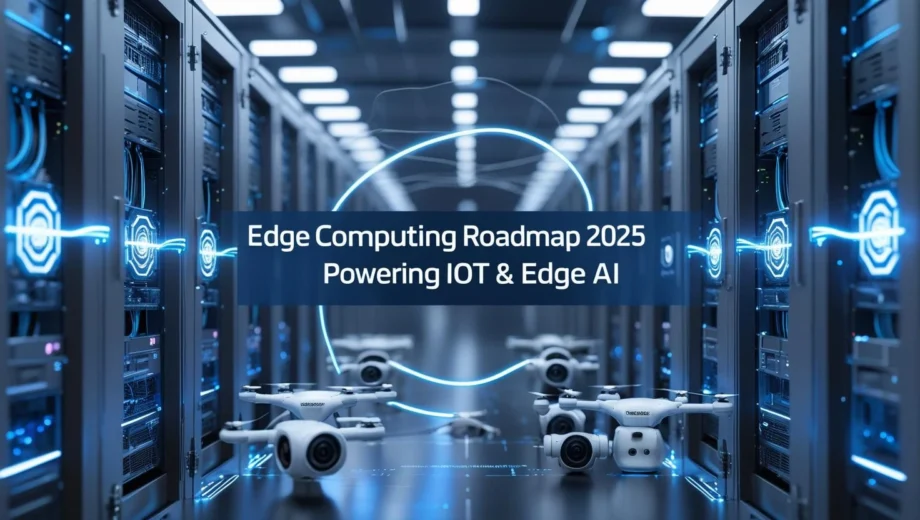Introduction: The Shift from Cloud to Edge Has Begun
Edge computing in 2025 is not just another buzzword — it will be the throbbing pulse of how businesses process data in real time today. From the smart city sensors monitoring traffic to AI-powered machines on the factory floor, we live in a time when milliseconds count — and cloud latency simply never will cut it.
The classic cloud is so overloaded because of the explosion of IoT devices and AI apps. Enterprises need now decentralized, local data processing transmitting instant results. That’s where edge computing comes in — the idea of moving computation closer to where data is generated.
In this roadmap, we’ll break down:
- What edge computing is used for,
- How to build your IT roadmap for edge data processing,
- How and where to buy edge servers,
- Case studies from industry leaders like Intel and NVIDIA,
- And what the future holds for this transformative tech.
Whether you’re a CTO, system architect, or just passionate about next-gen tech, this guide is your compass for navigating the edge revolution in 2025.
What Is Edge Computing Used For?
Before we dive into strategy, let’s answer the most popular question:
What is edge computing used for?
Imagine data being processed right where it's created—whether it's a sensor on an oil rig, a camera on a delivery robot, or a wearable tracking your heart rate. That’s edge computing in action.
Key Applications
- IoT Data Processing
Smart homes, industrial sensors, and wearables stream massive volumes of data. Edge computing lets devices make decisions on the spot. - Real-Time AI Inference
From voice assistants to security systems using facial recognition, AI at the edge enables lightning-fast responses. - Autonomous Vehicles
Self-driving cars must make instant decisions—waiting on the cloud would be fatal. Edge computing ensures safety and speed. - Smart Factories
Real-time quality control, predictive maintenance, and energy optimization all happen on-site through edge nodes.
Why It Matters
- Latency Reduction: No delays = real-time decision-making
- Bandwidth Efficiency: Only critical data is sent to the cloud
- Enhanced Security: Local processing keeps sensitive info off the internet
In short, edge computing is mission-critical for any industry that values speed, privacy, and reliability.
IT Roadmap for Edge Data Processing: A 6-Phase Strategy
A successful edge deployment isn’t plug-and-play. It requires a strategic, step-by-step plan. Here’s your six-phase IT roadmap to navigate the edge landscape with confidence:
Phase 1: Needs Assessment & Use Case Identification
Begin by asking the big questions:
- Where does latency matter most?
- Which operations can’t afford downtime?
- What data must stay local due to privacy laws?
Use this phase to map your business-critical scenarios—whether it’s fleet tracking, smart cameras, or remote patient monitoring.
Pro Tip: Collaborate with IT, operations, and security teams to build a unified vision.
Phase 2: Edge Hardware Deployment
Now it's time to roll up your sleeves and install your gear:
- Edge Servers: Compact, powerful, and ruggedized
- IoT Gateways: Connect edge devices to local or cloud networks
- Sensors: Thermostats, cameras, pressure gauges, etc.
Choose hardware with:
- AI acceleration (NVIDIA Jetson or Intel Movidius)
- 5G/6G support
- Modular architecture for scalability
Phase 3: Edge AI Integration
Edge computing becomes truly intelligent when AI enters the picture.
Deploy optimized AI models on-site for:
- Predictive maintenance
- Image and voice recognition
- Fraud detection
- Inventory tracking
Leverage:
- OpenVINO Toolkit (Intel)
- Triton Inference Server (NVIDIA)
- Pretrained models fine-tuned for your needs
Real-time decisions with zero reliance on cloud latency—that’s the magic of edge AI.
Phase 4: Network Architecture & Connectivity
To avoid bottlenecks, build a hybrid architecture that balances local and cloud resources.
Key components:
- 5G/6G Networks for ultra-fast data transport
- SD-WANs for dynamic traffic control
- Edge-to-Cloud Pipelines for long-term data storage and training
You need resilient, redundant connectivity—especially in mission-critical sectors like healthcare or defense.
Phase 5: Data Management & Security
More endpoints = more attack vectors.
Mitigate risks with:
- Encryption at rest and in motion
- Role-based access controls
- Zero Trust architecture
Also, automate compliance monitoring for laws like GDPR, HIPAA, and CCPA. Privacy and performance must go hand in hand.
Phase 6: Monitoring & Optimization
Once live, edge environments require continuous tuning.
Deploy:
- Telemetry tools like Grafana or Intel’s Open Edge Insights
- AI-driven analytics to detect bottlenecks or failures
- Remote update systems to patch devices securely
Edge environments should evolve with your business—adapt, learn, and optimize.
Buy Edge Servers: Who, Why & How
Now that you’re ready to scale, here’s how to buy edge servers smartly:
Who Needs Them?
- Enterprises with distributed operations (retail, energy, manufacturing)
- Telecom Operators deploying mobile edge computing
- IoT Developers looking to run inference on-device
What to Look For:
- Specs: Multi-core CPUs, rugged build, GPU or VPU support
- Vendors: Intel, Dell, Supermicro, Lenovo, or NVIDIA for AI-focused nodes
- Support: 3–5 year warranty, firmware updates, SLA-backed tech support
Pro Tip: Think long-term. Choose modular, upgradable systems for futureproofing.
Spotlight on Intel Blog: Your Edge Intel
If you want to stay ahead, the Intel Blog is a goldmine.
What you’ll find:
- Industry case studies in retail, energy, and smart cities
- Deep dives into Intel hardware for edge AI
- Tutorials on OpenVINO, edge-to-cloud architecture, and more
Intel’s commitment to open innovation makes their blog a must-read for every edge strategy leader.
Branded Case Study: Intel & NVIDIA Lead the Way
Intel’s Edge Arsenal
- Xeon-D Processors for real-time inference at the edge
- OpenVINO Toolkit for seamless AI model deployment
- Partnerships with carriers for 5G-enabled MEC deployments
NVIDIA’s Edge Stack
- Jetson Nano / Xavier / Orin for compact AI modules
- NVIDIA EGX: Enterprise-grade edge platform
- CUDA + Triton: Powering thousands of AI edge applications
Together, Intel and NVIDIA are not just vendors—they're ecosystem builders driving the edge revolution.
Global Edge Computing Case Studies
🇩🇪 Germany: Smart Factories
Bosch integrates edge servers and sensors for real-time machinery health checks. Downtime? Reduced by 30%.
🇯🇵 Japan: Hospital Systems
Hospitals leverage Intel-powered gateways to monitor patients continuously, reducing cloud dependency and latency.
🇦🇪 UAE: Smart Surveillance
Dubai's AI-driven surveillance analyzes faces and behaviors in real-time—thanks to edge AI and NVIDIA Jetson modules.
These examples prove edge computing’s global potential across industries.
Challenges & What’s Next
Let’s be real—edge computing isn’t plug-and-play.
Challenges:
- Managing thousands of edge nodes
- Integrating with legacy systems
- Securing physical edge devices
Future Trends:
- Federated Learning: Decentralized AI model training without moving raw data
- AI-Powered Edge Orchestration: Dynamic workload balancing
- 6G Networks: Hyper-real-time communication unlocking tactile internet
The future is intelligent, distributed, and hyper-connected—and edge computing is at the center.
✅ Conclusion: Embrace the Edge. Own the Future.
Edge computing isn’t just another infrastructure trend—it’s a strategic necessity for modern, real-time operations. Whether you’re building smart cities, autonomous fleets, or predictive maintenance systems, your success in 2025 hinges on one thing:
A well-executed edge computing roadmap.
With leaders like Intel and NVIDIA, the tools are already here. It’s time to move from cloud-reliant to edge-empowered.
Don’t miss: CTO Career Roadmap 2025 – a perfect companion article for strategic tech leaders.








